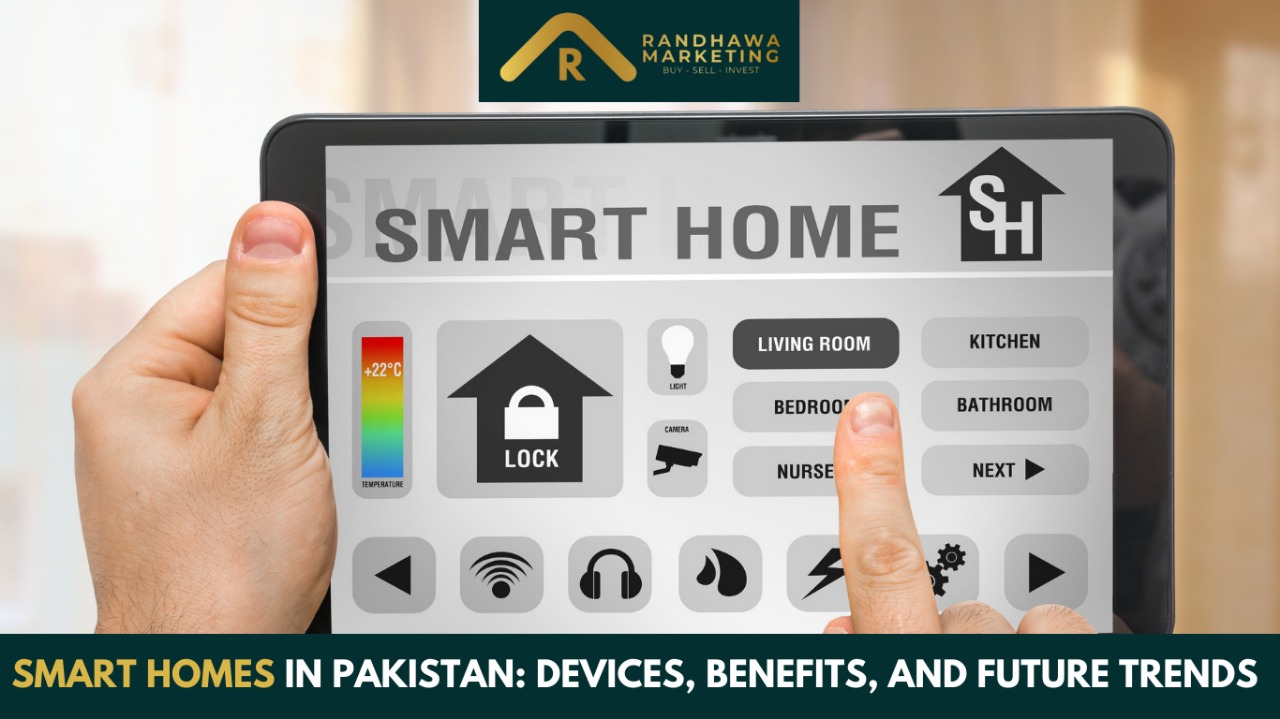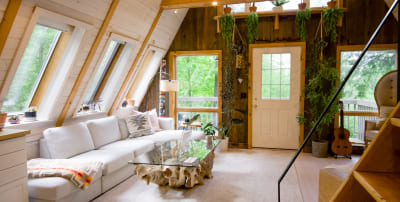
Smart Homes in Pakistan:
Devices, Benefits, and FUTURE TRENDS
Smart homes rely on connected
devices and IoT systems that let you control and automate key functions such as
lighting, security, climate, and appliances. You can manage these systems
through mobile apps, voice commands, or pre-set schedules.
In Pakistan, this technology is
still at an early stage but gaining traction. The strongest adoption is
happening in major urban centers like Karachi, Lahore, and Islamabad.
Developers in premium housing societies and upscale apartment projects are
introducing smart features as selling points. Demand is driven by buyers who
want energy savings, convenience, and better security.
Middle-income households are
showing interest too, but high upfront costs remain a challenge. As devices
become more affordable and internet access improves, adoption is expected to
expand beyond luxury projects.
Key Smart Home
Devices and Systems in Pakistan
Smart
lighting
Energy-efficient LED bulbs, motion-sensor lights, and schedule-based lighting
systems are becoming common. These solutions help reduce electricity bills and
provide convenience by adjusting automatically to your needs.
Thermostats
and climate control
Although still less common, smart thermostats and automated climate control
systems are emerging in high-end homes. They adjust heating and cooling based
on occupancy or set schedules, improving comfort and energy savings.
Security
systems
CCTV cameras, smart locks, video doorbells, and motion sensors are among the
most in-demand devices. Homeowners value real-time monitoring and remote access
for added safety.
Voice
assistants
Devices like Amazon Alexa and Google Assistant are used to control lighting,
entertainment, and other smart devices. They allow hands-free management and
easy automation.
Health
and wellness devices
Wearables such as fitness trackers and remote health monitoring systems are
being adopted. These devices track vital signs, promote healthier living, and
offer peace of mind for families.
Energy
monitoring tools
Smart meters, energy-efficient HVAC systems, and solar integration are gaining
popularity. These tools help manage consumption, cut costs, and support
sustainable living.
Benefits of Smart
Home Technology in Pakistan
Energy savings
Rising electricity prices and frequent load shedding make energy efficiency a
top priority. Smart thermostats, automated lighting, and sensor-based
appliances help reduce unnecessary usage. These technologies cut down
electricity bills and make daily life more manageable during power shortages.
Improved
security
Concerns about theft and unauthorized access are common in many areas. Smart
home security systems provide real-time monitoring through cameras, motion
sensors, and video doorbells. Homeowners can lock or unlock doors remotely and
receive instant alerts, giving them better control over their property’s
safety.
Convenience
and control
Smart devices let homeowners manage their homes directly from a phone or
through voice commands. Routines can be automated, such as turning on lights at
sunset or adjusting the air conditioning before arrival. Remote access also
means you can monitor and control your home even when traveling.
Increased
property value
Houses equipped with smart home technology often attract more attention from
buyers. Premium features like automation, advanced security, and energy
management give properties a competitive edge in the market. For developers,
including smart solutions can help projects sell faster at better prices.
Sustainability
Smart devices also support eco-friendly living. Automated energy management,
water-saving technologies, and integration with solar systems help reduce
waste. Many new housing projects in Pakistan are starting to include these
sustainable features as part of their design.
Future Trends in
Smart Homes and IoT in Pakistan
Smart
features in new housing projects
Developers are increasingly adding automation and IoT systems as standard
offerings in new villas, housing societies, and apartments. These features are
most common in upper-middle and high-end projects, where buyers are willing to
pay for added convenience and security.
Falling
costs through local production
As demand grows, local assembly and manufacturing of smart devices may reduce
costs. This will make products like smart lighting, plugs, and meters more
accessible to middle-income households.
Integration
with solar power
With energy shortages and rising costs, smart homes will increasingly combine
solar panels with intelligent systems that manage power generation and
consumption. This integration can help households reduce dependence on the
grid.
Expansion of
smart metering
Utility companies and housing developers are expected to adopt smart meters for
water, gas, and electricity. These devices will allow users to track usage in
real time and manage resources more efficiently.
Predictive
maintenance with IoT
Buildings will use IoT sensors to monitor systems like air conditioning,
heating, and water pumps. Predictive alerts will help prevent breakdowns and
reduce repair costs.
Voice and
app-based ecosystems
Voice control through assistants like Alexa and Google Home will grow. In the
long term, local apps and platforms tailored to regional languages and
preferences are likely to emerge.
Focus on
privacy and security
As adoption increases, homeowners will expect stronger protections for their
data. Secure communication channels, regular software updates, and local
storage options will become standard requirements.
FINAL THOGHTS
Smart
home technology in Pakistan is moving from concept to reality, with clear signs
of long-term growth. While the adoption is still concentrated in large cities
such as Karachi, Lahore, and Islamabad, awareness is spreading fast. The main
drivers are the need to cut electricity bills, improve household security, and
add convenience to daily life. Developers in premium projects are already
offering automation features to attract buyers, and this trend is likely to
expand to mid-tier housing once devices become more affordable.
The
challenges are real. High installation costs, unstable internet, frequent load
shedding, and limited local support for imported devices slow down adoption.
Many homeowners are also cautious due to concerns about data privacy and reliability.
However, with time, these barriers are expected to shrink. Local assembly of
smart devices, better connectivity through 4G and 5G, and integration with
solar energy solutions will make smart homes more practical for a wider
audience.
Looking
ahead, smart homes are set to reshape Pakistan’s housing sector. Automated
energy management, predictive maintenance of building systems, and smart
metering for utilities will become more common. Developers who adopt these
technologies early will gain a clear advantage, as buyers increasingly see
smart features as a necessity rather than a luxury. Over the next decade, smart
homes are likely to become a standard part of urban living in Pakistan,
contributing to both comfort and sustainability.
FAQs-Smart
Home Technology in Pakistan
1. What is a
smart home?
A smart home uses connected devices to automate and control things like
lighting, security, climate, and appliances. You can manage these systems
through apps, voice commands, or scheduled routines.
2. Are smart
homes available in Pakistan?
Yes, especially in major cities like Karachi, Lahore, and Islamabad. High-end
housing societies and upscale apartments are leading the way, while interest is
slowly growing among middle-income households.
3. What
devices are commonly used in smart homes?
Smart lighting with LEDs, motion
sensors, and schedules
Thermostats and climate control
systems
Security systems like CCTV, smart
locks, video doorbells, and motion sensors
Voice assistants such as Alexa
and Google Assistant
Health and wellness devices like
fitness trackers and remote health monitors
Energy monitoring tools including
smart meters, HVAC systems, and solar integration
4. What are
the main benefits of smart homes in Pakistan?
Lower electricity bills through
energy-efficient systems
Improved security with remote
monitoring and alerts
Convenience, as devices can be
controlled from your phone or by voice
Higher property value and faster
sales for homes with smart features
Support for sustainable living
through energy and water savings
5. What
challenges do smart homes face?
High upfront costs for devices
and installation
Dependence on stable internet and
reliable electricity
Limited awareness and trust, with
concerns about privacy and hacking
Compatibility issues between
different brands and lack of local support
6. How will
smart homes develop in Pakistan?
Developers will include smart
features as standard in new projects
Local production will reduce
device costs
Integration with solar power and
smart metering will grow
Predictive maintenance and
stronger security standards will become common
Voice-controlled systems and
local apps may become widely available
7. Are smart
homes practical for middle-income households?
Currently, they are more common in high-end homes, but as devices become
cheaper and infrastructure improves, more middle-income households will adopt
them.
8. Do smart
homes increase property value?
Yes, features like automation, energy efficiency, and security make properties
more attractive and can help sell them faster at better prices.


